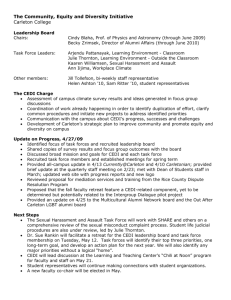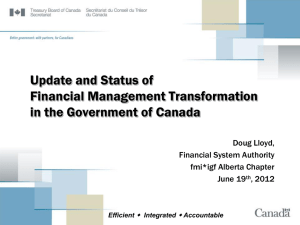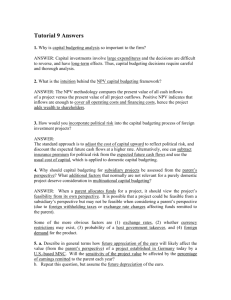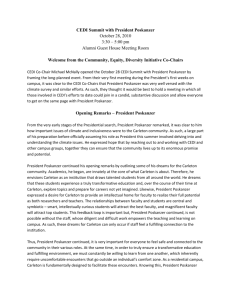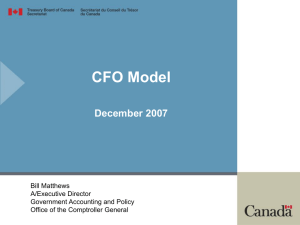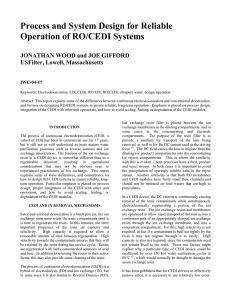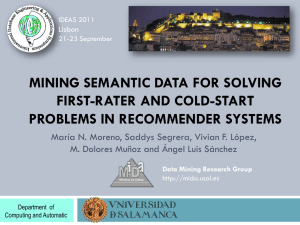Financial Management Transformation
advertisement
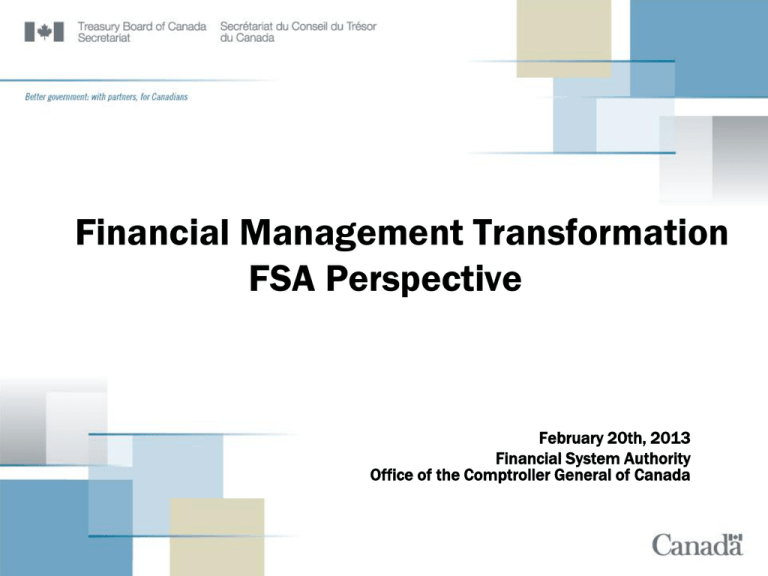
Financial Management Transformation FSA Perspective February 20th, 2013 Financial System Authority Office of the Comptroller General of Canada Objective of the session • FSA Mandate, Vision and Services • FSA Deliverables (Progress, Status and Next Steps) • Common Enterprise Data Initiative (CEDI) • Common Financial Management System Configuration (FM-SC) • Common Financial Management Business Process (FM-BP) Initiative • What’s Next • Questions and Discussion 2 FSA Vision and Services 3 Common Enterprise Data Initiative (CEDI) CEDI Outcomes • CEDI provides the foundational structure to collate meaningful financial and material information across government. • Target outcomes for CEDI continue to include: – Better information and improved financial management services. – Help address long standing operational and reporting inefficiencies. – Enabler for open data. Strategic Environment Continue emphasis on convergence towards common (processes, systems, information). • • FM Transformation, ASR, SOR, DRAP, HRSDC SAP build, … CEDI provides guidance on common information needs and strategic requirements to organizations and projects building common solutions. Increasing demands for more relevant and timely information supporting GC-wide financial analysis and resource management. • • • CIOB – IT expenditure reporting EMS – How much is spent on policy development compared to front-line service delivery? Open Data, … CEDI works with stakeholders to define new information needs and propose solutions, and (as appropriate) issues requirements and data standards to support implementation. CEDI Approach • Guided by a target-state model, CEDI supports standardization of financial information by: – Developing and issuing data standards, – Providing guidance to key initiatives (e.g. HRSDC), and – Providing a framework to help enable Open Data initiatives. Strategic Direction (Governance) ASR,SOR, DRAP,… FM Transformation Open Data Information model integrates with FM-BP process model, and FM-SC requirements model. FM-BP Financial Information Model defines: • The scope of financial and related nonfinancial information. • What each piece of information means. • Requirements for common data elements and identifiers. • Authoritative sources for standard data elements. CEDI Target-State Financial Information Model Guidance to initiatives Issue data standards Support Open Data (information and reporting requirements and capabilities) (e.g. vendor, customer, DCOA, etc.) (data definitions and semantics, identify authoritative sources) Status of CEDI Data Standards Approval Step DCOA Standard and Line Object Guideline Vendor Record Customer Record Materiel Coding (Procurement Item Classification) CFO Consultation Jun 2011 Mar 2012 Jan/Feb 2013 DCC Sep 2011 May 2012 Apr/May 2013 POC Nov 2011 May 2012 Apr/May 2013 Approval Mar 2012 Jun 2012 May/Jun 2013 Effective Date Apr 2012 Jul 2012 Apr 2014 Visit www.gcpedia.gc.ca/wiki/CEDI for draft standards and background documentation. 8 Information Model • The Information Model must address: – Enterprise and GC-wide information needs – Policy driven process and control requirements – Interoperability requirements (information crossing system and organizational boundaries) – Supporting common business processes and common system configurations • The Information Model would be a ‘living document’ – continually being refined and updated to meet the requirements of the stakeholders. – The scope of creating the entire Information Model at once is not possible given the immediate need and the available resources. The most relevant sections, including leveraging previous sections of CEDI, would provide the baseline. 9 CEDI going forward: The Information Model • The Information Model will be the repository for enterprise level business and information needs that will be supported operationally through common processes and common systems – Data components would mean one thing across all of Government allowing apples to apples comparisons for open Government • The information model will define the data elements that describe financial and related non-financial components of the GC (defining unambiguously concepts of materiel, programs, funds, organization, products and services) and document associated business needs and requirements that are important to the Enterprise • The Information Model will also help define that data components can only be used for their intended purpose – A key tenant of being able to do Open Data Initiative is that customization of data elements cannot be done at the Departmental level 10 Common Financial Management System Configuration Requirements (FM-SC) Financial Management System Configuration (FM-SC) The purpose of the Financial Management System Configuration Initiative (FM-SC) is to identify a set of departmental financial management system (DFMS) configuration requirements for the Government of Canada (GC) within the context of its current legislative and policy framework. The FM-SC is intended to apply to all departments and agencies as defined in section 2 of the Financial Administration Act (FAA). The end result of this initiative will be the Financial Management System Configuration Guideline. Per the Directive on the Stewardship of FMS: Role of the Chief Financial Officer 6.1.3 Implementing FMS cluster group system configurations and OCG-endorsed system functionality as they are established or made available from time to time. Role of the Chair of the FMS cluster group management board 6.4.1 The chair of the cluster group management board is responsible for evolving the cluster configuration in alignment with the criteria established by the OCG for cluster configurations. 12 FM-SC Components • • • • • • • • • • • • General Ledger management Planning, budgeting and forecasting Appropriation and commitment control Procurement Expenditure and payables management System management Asset management Inventory management Pay administration Travel management Revenue and receivables management Reporting 13 Interface requirements • Each component within FMSC identifies Interface requirements at a high level • Example from Travel Management: – Export travel expense data to Shared Travel Services for reporting purposes. – Import travel transaction data from the Shared Travel Services reporting service for integration with departmental reporting. 14 Common Financial Management Business Process (FM-BP) Initiative The Common FM-BP Initiative Goal: To develop an integrated framework of ‘should be’ common processes that standardize and modernize the delivery of financial management Approach: OCG sponsored in collaboration with departments and agencies, financial systems clusters, policy authorities and service providers Deliverables: • Guidelines which will provide: Standardized process definitions – System- independent, modular, interoperable – Common to all departments and agencies – Describes roles and responsibilities in detail “RACI” data analysis includes identification of: – Responsible, Accountable, Consulted, and Informed resources; and – Authoritative data sources Process Flows – Flow diagrams 16 The Common FM-BP initiative scope and governance Governance Project Operations Business Processes organized into Domains and Cross functional areas 17 Common FM-BP Initiative Linkages Departmental Operations GC-wide Direction Departments (DM/CFO, Management) Service Providers Cluster Groups Mazankowski Tellier Report Requirements, Expertise Reports to the Prime Minister on the Public Service Services Sector Finance Council Recommendations Strategic Direction Common Processes Common FM-BP Initiative Fulfillment Policy Centres & Central Agencies Validation Enablement Policies, Directives, Standards, Guidelines, Tools Blue Ribbon Panel Standardization through Collaboration Annual Budgets Horizontal Initiatives CEDI STSI Grants & Contributions 18 FM-BP models Planning Budgeting & Forecasting • Manage Planning & Budgeting • Manage Forecasting & Budget Review Revenue & Accounts Receivable • Manage Revenue, Receivables & Receipts • Manage Interdepartmental Settlements • Manage Collection of Overdue Receivables Expenditure & Accounts Payable • Manage Procure to Payment • Manage Travel • Manage Other Payments • Manage Distribution and Maintenance of Acquisition Cards HR/Finance Interactions • Pay Administration Materiel/Finance Interactions • Manage Other Capital Assets • Manage Real Property • Manage Inventory Transfer Payments • Manage Grants & Contributions Data • Manage Vendor Master Data File • Manage Delegation of Financial and Spending Authorities • Manage Departmental Chart of Accounts • Manage Customer Master Data File Integration • Manage Post-payment Verification • Manage Financial Close 19 Sample Level 2 Process Flow 20 Sample Level 3 Process Flow Comprehensive Process Flow Integrated view across all FM-BP processes Linkages to process description and RACI Consideration of controls 21 Sample Level 3 Sub-Process RACI Linkages to process description and to process flow Related data identified Responsibility, accountability, and requirements to consult and inform are assigned to specific roles 22 Benefits Accruing from an FSA GOVERNMENTAL DEPARTMENTAL • Consistent business processes • Improved efficiency and information • Improved stewardship of strategic information to support Deputies and Ministers • Improved interoperability between departments and within departments • Improved cost-cutting and control through appropriate procurement instruments, and accountability in GC spending • Better strategic information to make decisions • Direct response to the Mazankowski/Tellier PM Advisory Committee report • New standards improving financial management through better information and reporting • Better controls and reports on economic spending • Better controls and reports on economic spending 23 What’s Next • Continue delivering on existing projects • Manage and deliver on MAF • Support CIOB in ERP exemptions & collaborate on Interoperability • Support Dept CFOs with guidance on systems • Work with Small Departments and Agencies • Continue to communicate message about Standardization to FM Community 24 Questions? 25 For More Information: Marcel Boulianne, PMP, Financial System Authority Financial Management Sector Office of the Comptroller General Treasury Board of Canada Secretariat Marcel.Boulianne@tbs-sct.gc.ca Telephone 613-946-4512 Info Links/URLs www.gcpedia.gc.ca/wiki/Fsa http://publiservice.tbs-sct.gc.ca/ocg-bcg/index-eng.asp http://publiservice.tbs-sct.gc.ca/fm-gf/abu-ans/standard-eng.asp 26 27 27
